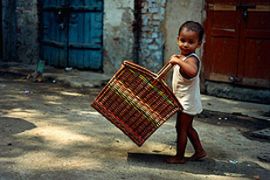Children ‘left out’ of Asia’s boom
UN report highlights healthcare worries as gap widens between rich and poor.

Unicef said that more than 40 per cent of the world’s children who died before their fifth birthday in 2006, were from the Asia Pacific region.
The agency said that the main killers were pneumonia, diarrhoea and malnutrition but that “the vast inequalities in income, geography, gender and ethnicity are essentially what stand in the way of children surviving and thriving”.
Healthcare worries
The report said South Asia was lagging behind on public spending on health care, with only 1.1 per cent of gross domestic product allocated to the sector.
At least 2.1 million children under the age of five died in India in 2006. The report called on the country, where last year economic growth was about nine per cent, to improve its health care, nutrition, education, gender equality and child protection policies.
The report also said that a boom in private sector health care for the region’s expanding middle classes was affecting the public sector by tempting qualified staff to better paying jobs in private clinics or overseas.
Anupama Rao Singh, Unicef’s regional director for East Asia and the Pacific, told Al Jazeera that she saw two main reasons for the low public expenditure on public healthcare in Asia – a growing move towards the privatisation of healthcare and the decetralisation of government authority.
“In the recent past here has been a real effort at privatising many of the basic social services, as a result of which government’s invest less and expect families and communities to pay the additional costs,” she said.
“But the pace of economic growth in Asia is one of the fastest in the world so there are new revenues and resources available within the countries which can be put to public uses … and the international community still has a role to play especially in the least developed countries.”
Growing population
According to global population studies, India will likely surpass China to be the world’s most populous country within 20 years.
With half of the world’s children living in the Asia Pacific, the report said that extending health services to the poorest people was key to achieving the 2015 global goal of reducing under-five mortality by two-thirds of 1990 levels.
“However the region’s robust economic growth, the fastest in the world since 1990, has lifted millions out of poverty,” Unicef said in a separate statement.
Within the region, Southeast Asia made the largest strides in combating child deaths, with mortality for under-fives now half what it was in 1990.
In China, Unicef reported that child mortality had dropped between 1970 and 1990, but said the decrease had since slowed and that the country needed to take big strides to regain early progress.
“China’s overall disease profile now resembles that of an industrialised country, but inequities in access to quality health care and huge disparities in health outcomes remain prevalent and entrenched,” the report said.
However, overall the mortality rate for children under five years of age had dropped 34 per cent in Asia pacific since 1990.
Out of every 1,000 births in the region in 2006, at least 59 infants died before their fifth birthday. The 2015 target is 30 deaths per 1,000 births.